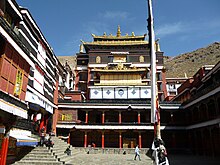Trashilhünpo
| Tibetan name |
|---|
|
Tibetan script :
བཀྲ་ ཤིས་ ལྷུན་ པོ་
|
|
Wylie transliteration : bkra shis lhun po
|
|
Official transcription of the PRCh : Zhaxilhunbo
|
|
THDL transcription : Trashilhünpo
|
|
Other spellings: Tashihlünpo, Tashilhunpo, Tashilhümpo
|
| Chinese name |
|
Traditional :
扎什倫布寺
|
|
Simplified :
扎什伦布寺
|
|
Pinyin : Zhāshílúnbù Sì
|
Trashilhünpo Monastery ( Tib . : bkra shis lhun po ) is located in the west of the Samzhubzê district of the city of Xigazê in the Tibet Autonomous Region of the People's Republic of China . It is the traditional seat of the Penchen Lama .
history
The monastery was founded in 1447 by Gendün Drub . Gendün Drub was one of the two most important disciples of Tsongkhapa , the great reformer who founded the Gelug tradition. Gedün Drub was later (retrospectively) classified as the first Dalai Lama. Trashilhünpo is one of the very large monastic universities of the Gelug School for the training of Buddhist scholars ( Geshe ).
Penchen Lobsang Chökyi Gyeltshen became abbot of Trashilhünpo in 1601. He was the first to bear the title "Penchen Lama" - one of the most important authorities of Tibetan Buddhism - although he was later referred to as the fourth incarnation. Trashilhünpo has been the seat of the Penchen Lama since then. Lobsang Chökyi Gyeltshen became the 5th Dalai Lama's most important study director and had the monastery enlarged.
During the Cultural Revolution , parts of the monastery were destroyed, including the grave stupas of the 5th to 9th Penchen Lama. Most of the original 5000–7000 monks were imprisoned or murdered, around 250 fled abroad, where they rebuilt the monastery in exile. It was not until the 1980s that the restrictions on religious practice were relaxed and the monastery was rebuilt.
In 1982, the Chinese central government made several tons of gold, silver and bronze available for restoration. With donations from the government of Tibet and the then administrative district of Xigazê (today: City of Xigazê) as well as personal donations from the 10th Penchen Lama and many believers, the monastery was rebuilt by the end of the 1980s.
The large Maitreya statue of Trashilhünpo was ritually dressed with a new Kasaya in 1904, 1957 and 1985 .
On January 30, 1989, Li Peng signed the resolution to build a grave stupa for the 10th Penchen Lama, which was completed in August 1993.
The 11th Penchen Lama Gyeltshen Norbu , recognized by the Chinese government, is not recognized as a legitimate reincarnation by the current 14th Dalai Lama .
architecture
The Tashilhünpo Monastery covers an area of 18.5 hectares. The largest buildings, in the center of the monastery complex, are the Maitreya Hall and the hall with the grave stupas of the Penchen Lamas.
In the Maitreya Hall there is a 26.2 m high statue of a seated Buddha (it is the second tallest sitting Buddha in a hall - after the Daibutsu of Tōdai-ji of Nara ) made of gold and bronze, decorated with precious stones and coral, which is said to have been built by 900 workers in nine years in 1914 under the 9th Penchen Lama Lobsang Thubten Chökyi Nyima .
Some stupas in the Hall of the Grave Stupas contain the remains of several Penchen Lamas and other relics ( ring gsal ). The 10th Penchen Lama Thrinle Lhündrub Chökyi Gyeltshen is also buried here. Its stupa is adorned with 614 kg of gold, 868 precious stones and 246,794 jewels. The stupa, built in 1993, is the most valuable tomb in all of China since 1950.
In addition to numerous other statues, the monastery also houses numerous wall paintings, masterpieces of Buddhist art.
Cham
The religious dance cham (Chinese qiangmu) of the monastery is on the list of the intangible cultural heritage of the People's Republic of China (III-22 (125) Rikaze Zhashilunbu si qiangmu 日喀则 扎什伦布寺 羌 姆).
monument
The monastery has been on the list of monuments of the People's Republic of China (1-109) since 1961 .
literature
- Phuntsok Namgyal (phun tshogs rnam rgyal) (chief editor): Tibetan Buddhist monastery Bkra-sis-lhum-po . Encyclopedia of China Publishing House, Beijing 1998, ISBN 7-5000-6101-3 .
- Tanjun Ranopanza: The Tashilhunpo Monastery . The residence of Grand Masters Panchen (Beijing, Foreign Language Publishing House 1993), ISBN 7-119-01618-0 .
Web links
- Монастырь Ташилхунпо - резиденция Его Святейшества Панчен-ламы ( The Zhaxilhünbo Monastery, Seat of His Holiness the Panchen Lama ; in Russian)
Individual evidence
- ^ John Powers : Introduction to Tibetan Buddhism . Snow Lion, Ithaca / Boulder 2007, passim.
- ↑ Tashi Lhunpo Monastery Website of the exile Tibetan monastery in Karnataka , India (in English)
- ↑ Tibet's missing spiritual guide ( BBC , May 16, 2005)
- ↑ tibet.news.cn: 非 物质 文化遗产: 日喀则 扎什伦布寺 羌 姆 ( Memento of the original from March 1, 2011 in the Internet Archive ) Info: The archive link was inserted automatically and has not yet been checked. Please check the original and archive link according to the instructions and then remove this notice. - Retrieved May 7, 2011
Coordinates: 29 ° 16 ′ 7 ″ N , 88 ° 52 ′ 12 ″ E








